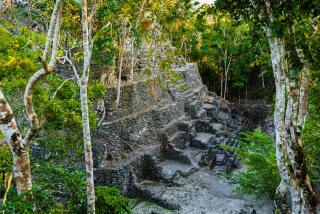Tomb of Early Maya Ruler Believed Found in Guatemala
Archeologists in Guatemala have uncovered what they believe is the unlooted tomb of the first ruler of Waka, a wealthy Maya city that played a major role in the centuries-long war between the dominant empires of Calakmul and Tikal.
The unnamed ruler, who lived around AD 200, established a dynasty that produced 22 kings over 700 years.
“If this is indeed the founder, it is the discovery of a lifetime,” archeologist David Freidel of Southern Methodist University said Wednesday. Freidel directs the project along with archeologist Hector Escobedo of the Universidad de San Carlos de Guatemala.
Waka, known today as El Peru, sits on an escarpment three miles north of the San Pedro Martir River. The city’s control of trade along the river made it very wealthy. At its height, Waka had tens of thousands of inhabitants and formed alternating alliances with each of the two nearby cities.
The site in the Laguna del Tigre National Park in northern Guatemala contains 672 monumental structures and countless smaller buildings. It was rediscovered by oil prospectors in the 1960s and quickly mapped by Harvard University archeologist Ian Graham in the 1970s, but Freidel and Escobedo are the first to explore it thoroughly.
Escobedo and graduate student Juan Carlos Melendez found the tomb Friday. It lies at the base of the city’s largest pyramid, which is nearly 60 feet tall. Aside from its collapsed vaulted roof, the tomb otherwise appeared undisturbed.
It contains a single skeleton lying on a stone bench. The body appeared to have originally been placed on a jaguar pelt, but all that remained of the pelt were the claws, Freidel said in an e-mail message.
Some of the jade ornaments near the remains apparently had been sewn onto fabric or other material. One of those jewels, he said, is a huunal, or royal insignia.
An imported alabaster vase “attests to the wealth of the court at Waka even at this early date, and it is likely that the trade routes which this city commanded were already busy,” Freidel noted.
Other offerings on the bench included several blackware drinking cups, a large painted plate and several plain plates.
The team hopes to learn more when it removes the skeleton for examination.
“What is clear now is that Waka was a precocious royal court, with important rulers already, at the beginning of the Classic period [AD 250 to 900] when the institution of dynasty took hold,” Freidel said.
On Tuesday, students on the team found what appeared to be a second royal tomb farther up the pyramid, one that dates from about 400 years later.
That tomb has not been opened, but an elaborate offering of a dozen miniature figurines of ballplayers, elegant women, dwarfs and seated lords found outside it suggests its royal status.
The team has been racing against looters. The day before Escobedo and Melendez discovered the tomb, thieves had sneaked into the tunnel the archeologists had dug under the pyramid and cleared out rocks and rubble in a search for treasure.
More to Read
Sign up for Essential California
The most important California stories and recommendations in your inbox every morning.
You may occasionally receive promotional content from the Los Angeles Times.







